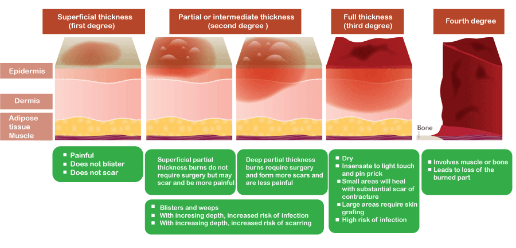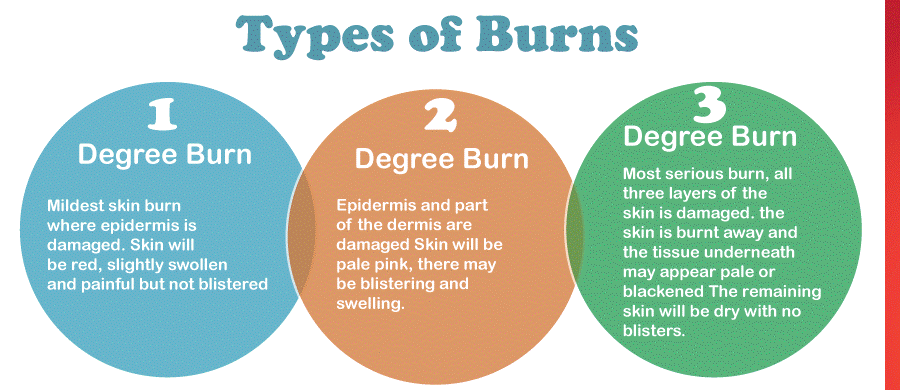Burns Definition"Burn" refers to damage caused by contact with thermal, chemical, or electrical agents to the epidermis, dermis, or deeper tissues. There are two types of responses in burn pathophysiology: local and systemic. When too much heat is applied to the skin, it radiates from the initial site of contact and creates a local reaction with three zones that extend in all directions. The body's reaction after a burn might be extremely strong. Two clinically important processes take place in a big burn. Increased capillary permeability and widespread extravasation of fluid and proteins from the intravascular to the extravascular region are caused by the release of systemic inflammatory mediators and cytokines. Proinflammatory substances like interleukin (IL)-1, IL-6, and tumor necrosis factor-alpha (TNF-alpha) are released during the healing of wounds. This encourages persistent inflammation and leads to the formation of different inflammatory cells in the tissue in question. Beginning in the injured tissue is angiogenesis. Prostaglandin E2 and tumor necrosis factor-alpha also contribute to developing the inflammatory response during wound healing. Scarring after the burn is possible if the establishment of this reaction is damaged in any way. Transforming growth factor-beta (TGF-beta) secretion, released by myofibroblasts and other inflammatory cells, is the main cytokine responsible for scar formation. When burning does not touch the reticular layer, a hypertrophic scar does not form. As a result, the reticular layer's inflammatory cells, fibroblasts, freshly formed blood vessels, and collagen deposits generate hypertrophic scar tissue. 
EtiologyThe skin must be exposed to a minimum of 44�C of heat to become burned. Moreover, the length of the heat exposure is crucial; transepidermal necrosis, which happens at 70�C of heat in a second, happens at 47�C in 45 minutes. The types of burns include thermal, chemical, electrical, and radiation. Common thermal burns include those brought on by contact with hot objects, hot liquids, or hot vapors and those brought on directly by hot flames. Since each case of burns requires a different course of therapy, the cause of the burns should be understood. The contact length and temperature determine the extent of cell damage. Burns may result from chemical burns brought on by the corrosive effects of acid or alkali salts and solutions. In addition, electrical current, radiation, UV, and laser beams can all cause burns. During combat, serious burns from combustibles, explosives, and weapon flames are possible. Types of burnsThere are mainly six types of burns: 1. Thermal burnsAs hot water and flame burn, it takes two different forms. Thermal burns are heat-related skin injuries commonly resulting from touching hot objects, liquids, steam, or flames. Cellular death results from thermal injury to the skin and depends on the temperature and duration of contact. Thermal burns are the most frequent type of burn injuries, accounting for around 86% of patients needing admission to a burn centre. Children suffer from burns in about 70% of cases. Hot beverages or hot bath water are the main causes. These are typically first-degree or second-degree burns with superficial scarring. Flames cause 50% of adult burns. Moreover, it may potentially result in inhalation burns. In most cases, it looks like a second or third-degree burn. 2. Chemical burnIt is the cause of burns brought on by household cleaning products or workplace mishaps. Chemical burns comprise 3-6% of all burns but account for 14-30% of burn-related fatalities. It typically develops due to exposure to very acidic or alkaline substances. There is more contact with the agent than there is with thermal burns. The chemical substance may cause systemic symptoms and injuries in the moues esophagusagus, and stomach, where it touches when inhaled or consumed. The most frequent causes of chemical burn occurrences are bleach, cement, plaster, hydrofluoric acid used in glassware artwork, phenol, petroleum-derived organic chemicals, and phosphorus used in the manufacture of various warfare munitions. 3. Electrical burnElectric burns, the most common, cause 20% of burn-related deaths in men between 20 and 40. Lightning strikes or electric currents cause it to happen. Electrical burns between 250 and 1000 volts, like high-voltage ones, should be monitored because these patients may experience unconsciousness, compartment syndrome, and myoglobinuria/hemoglobinuria. Burns from low-voltage incidents are confined to the skin but extend deeper into the tissues. There are signs of high-voltage incidents, such as stapler piercing, ulceration, and scarring. Necrotic regions of a lightning strike develop along the line from where the electricity entered. Systemic problems, such as heart arrhythmia, necrotic regions in the soft tissues and bones, and thermal damage may manifest due to direct contact with the electricity as the current goes through the entire body. 4. Radiation burnIt results from the ingestion of radioactive substances. High radiation doses (8-10 Gy) can result in local radiation burns that resemble thermal burns, except for a few days to a few weeks of delayed latency. High doses result in abrupt cell death. Lymphocytes and hematopoietic cells are the radiosensitive tissues. The dose affects the extent of radiation damage. The early discovery is erythema on the skin. Skin necrosis and ulceration may appear after several weeks of high-dose radiation exposure. 5. SunburnSunburn develops due to uncontrolled and prolonged exposure to sun or light sources containing UVB. Sunburn is contact dermatitis due to ultraviolet B rays (295-315 nm), the most erythematous wavelength. The formation of sunburn requires more ultraviolet light than the minimal erythematous dose. While 20 minutes is enough to get a minimal erythematous dose on a clear summer day, one full day of sunbathing is needed to reach 20 times the MED dose. People reaching this dose have sunburns with individual differences. The skin reaction starts at 4-6 hours and ends at 72 hours. 6. Cold burnIt is created while the body is being cooled. Under 22�C, irreversible changes take place, and the skin freezes. In contrast to thermal burns, cold burns cause direct injury to extracellular fluid and indirect damage to organ functions. When ice crystals form in the intracellular and extracellular fluid, electrolyte concentration rises, enzyme systems malfunction, and tissue deterioration starts. Ischemia and failure are exacerbated by vasoconstriction, endothelial injury, and thromboembolism. First, reflex erythema against the cold, followed by vasoconstriction and paleness, are signs of first-degree frostbite. With third-degree frostbite, blue-black color changes and stiffening are seen in addition to erythema, edema, and subepidermal bullae. It typically appears on the extremities, such as the fingers, nose, and ears. The body is affected by ischemia that starts in the tissue. Cytokines largely accountable are prostaglandins. Types of burn based on degreeSeverity levels categorize Burns by healthcare professionals. Your doctor will assess the severity of the skin injury based on these categories. Burn degrees consist of: First-degree burn- Mild first-degree burns (like most sunburns). Although the epidermis, the top layer of skin, often becomes red and uncomfortable, it rarely blisters. Secon-degree burn- Upper and lower layers of skin are affected by second-degree burns (dermis). There's a chance that you'll feel hurt, red, swollen, and blistered. Third-degree burns- The epidermis, dermis, and skin fat are all affected by third-degree burns. The burn also kills sweat glands and hair follicles. Third-degree burns harm nerve endings, so you usually won't feel pain directly where the burn is but rather nearby. Burned skin might appear leathery and be black, white, or red. 
What causes burns?Several things can result in a burn. The most frequent causes of burns are thermal sources like fire, hot liquids, steam, and contact with hot surfaces. Additional factors include being exposed to:
What symptoms indicate burns?Several symptoms may be present depending on the degree or severity of the burn. The initial hours or days following a burn are frequently when symptoms are the worst. Some burn signs include:
How are burns identified?To assess the degree or severity of the burn, your healthcare provider will examine it. The depth and percentage of the burn influenced by this procedure are estimated. Your doctor could categorize the burn as: Minor: First- and second-degree burns with less than 10% body coverage are regarded as mild and infrequently necessitate hospitalization. Moderate: 10% or more of the body with second-degree burns is moderate. Burns that affect the hands, feet, face, or genitalia can be mild to severe. Severe: Burns of the third degree covering 1% or more of the body are considered serious. How do burns get cared for or treated?The type and extent of the burn determine the appropriate treatment. Depending on the severity of the wounds, you need to keep all burns clean and apply the appropriate bandages or dressings. The aim is to treat the person's discomfort because poor control might hinder proper wound care. Keep checking wounds for indications of infection and other chronic problems, such as scarring and tightening of the skin covering joints and muscles that make it difficult for the patient to move. Therapies for various types of burns include: 1. Burns of the first degree
Moreover, there are over-the-counter painkillers available. 2. Burns of the second degreeSecond-degree burns are treated similarly to first-degree burns. The burned region can feel less painful and swollen if it is elevated. To destroy bacteria, your doctor might advise a stronger antibiotic cream that contains silver, such as silver sulfadiazine. 3. Burns of the third degreeSkin grafts are frequently necessary, which can be fatal for third-degree burns. Skin grafts replace damaged tissue with healthy skin from an adjacent, unharmed area of the patient's body. In most cases, the area from which the skin graft was obtained heals independently. A temporary supply of grafts can come from a deceased donor or a human-made (artificial) source if the injured person does not have enough skin accessible at the time of the injury. Still, they must eventually be replaced by the injured person's skin. More fluids are also given as part of the treatment (often intravenously via an IV) to maintain blood pressure and prevent shock and dehydration. What are the burn complications?Burns of the third degree that is severe and cover a big skin area is extremely dangerous and may even be fatal. Even first- and second-degree burns have the potential to develop infected, discolour, and leave scars. Burns of the first degree do not leave scars. Third-degree burn consequences could include the following:
How can I avoid getting burned?There are several unintentional causes of burns. The following actions can be taken to lower the risk of burns:
Next TopicBusiness Environment Definition
|
 For Videos Join Our Youtube Channel: Join Now
For Videos Join Our Youtube Channel: Join Now
Feedback
- Send your Feedback to [email protected]
Help Others, Please Share









